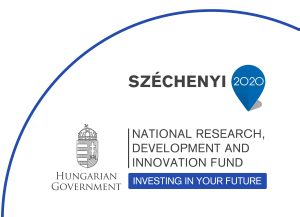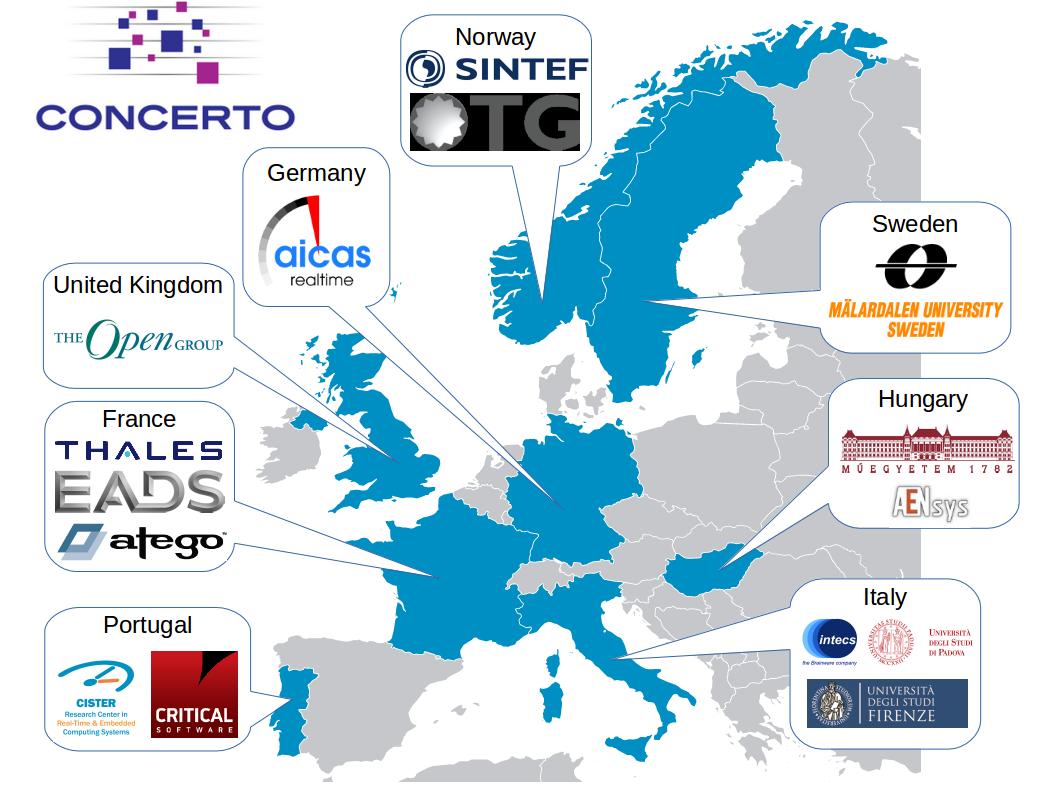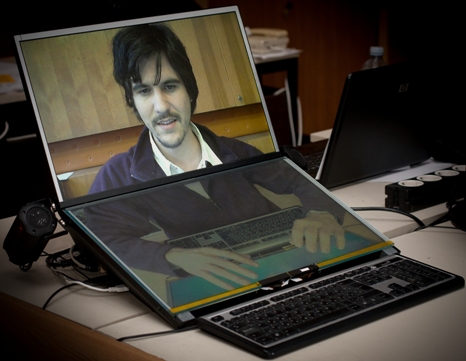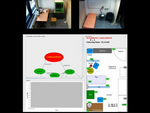project
CONCERTO - Guaranteed Component Assembly with Round Trip Analysis for Energy Efficient High-integrity Multi-core Systems
Project website: http://www.concerto-project.org
 (2013-2016) Emerging embedded systems platforms harnessing new heterogeneous, multi-core architectures to enable the next generation of powerful mission-critical applications are demanding across-the-board advances in all areas of design and development to fulfill their promise. The integration of component-based design with model-driven development creates a potent combination especially capable of mastering the complexity of these new systems.
(2013-2016) Emerging embedded systems platforms harnessing new heterogeneous, multi-core architectures to enable the next generation of powerful mission-critical applications are demanding across-the-board advances in all areas of design and development to fulfill their promise. The integration of component-based design with model-driven development creates a potent combination especially capable of mastering the complexity of these new systems.
|
Beneficiary: Budapest University of Technology and Economics |
 |
CONCERTO deliveres a reference multi-domain architectural framework for complex, highly concurrent and multi-core systems, where non-functional properties (including real-time, dependability, and energy management) are established for individual components, derived for the overall system at design time, and preserved by construction and monitoring at run-time.
The CONCERTO framework integrates:
- Correctness-by-construction for multi-core systems with innovative model-to-code transformation techniques targeted at their special characteristics.
- A multi-view, hierarchical cross-domain design space sufficiently rich to enable a compositional approach to the next generation of complex, heterogeneous platform architectures.
- Support for iterative and incremental development of multi-core systems through simulation and early model-based analysis, with fully automated back propagation of results to the user model.
- Hardware modeling facilities equipped to cope with the new generation of heterogeneous, multi-core platforms.
- Advances in run-time monitoring of mission- and operation-critical non-functional properties such as energy consumption on partitioned and multi-core processor architectures.
The applicability of the CONCERTO solutions to multiple industrial domains (including aerospace, telecoms, automotive, petroleum and medical) is ensured through the elaboration of representative industrial use cases.
The international consortium consisted of 15 members from 8 European countries (see the project webpage). The Hungarian partners were the Budapest University of Technology and Economics (leader of the "small consortium") and the AENSys Informatics Ltd., Szeged. Participating organisation units of BME were the Healthcare Technologies Knowledge Centre, the Department of Measurement and Information Systems, and the Department of Automation and Applied Informatics.

The Hungarian partners elicited the non-functional requirements relevant to the medical domain. Particular attention was paid to those non-functional requirements that could contribute to the certification, system performance, safety, verification and documentation, and to domain-specific requirements for the model simulation. They looked for solutions to provide seamless integration of the CONCERTO methodology into the medical, and in particular the telehealth and telecare domain with special attention to low-end medical devices used by non-specialists in the home environment. Appropriate analysis methodologies were identified for timing and analysis of subsystem behaviours, in compliance with medical system safety standards and support for certification requirements.
The medical use case run on a mobile computing platform with example patient monitoring devices, primarily as a telecare application. The CONCERTO toolset was used to evaluate the interaction between safety critical and functional aspects of the use case, partitioning between applications and timing characteristics of the system and interaction with the operating system. Qualitative and, if applicable, quantitative comparisons were made with other tools and techniques used in the medical and especially in the telecare domain. For the medical domain one of the key metrics considered was the benefit to requirement traceability and verification activities. An overall assessment of the various CONCERTO tools were provided in terms of usability, advantages, and areas for improvements.
Contact: Péter Hanák, BME EMT; Ákos Horváth, BME MIT; László Lengyel; BME AAIT, Vilmos Bilicki, AENSys.
| News and events | Publications |
M3W - Maintaining and Measuring Mental Wellness
 (2011-2015) The change of mental abilities is a normal process which already affects the population over 40 and strengthens with the age. Reading books, playing card and board games, solving crosswords are popular tools for keeping the mind fresh. With the spread of computers and computer networks computerized games are becoming more and more popular among the elderly. There are many websites offering games for everyone, however, only few of them are designed for the elderly as far as content, ergonomics, psychology, abilities, etc. are concerned. On the other hand, a continuously increasing number of websites are opened for the 50+, 60+ and older which rarely offer on-line games for the visitors. The aim of the M3W projekt is to utilize the fact that on-line games are able to collect behavioural data in order to measure mental (and motoric) abilities and especially their changes over time. If we can measure states and especially state changes in a scientifically sound way and a strictly controlled environment then we can provide better and more timely help for the elderly and their families.
(2011-2015) The change of mental abilities is a normal process which already affects the population over 40 and strengthens with the age. Reading books, playing card and board games, solving crosswords are popular tools for keeping the mind fresh. With the spread of computers and computer networks computerized games are becoming more and more popular among the elderly. There are many websites offering games for everyone, however, only few of them are designed for the elderly as far as content, ergonomics, psychology, abilities, etc. are concerned. On the other hand, a continuously increasing number of websites are opened for the 50+, 60+ and older which rarely offer on-line games for the visitors. The aim of the M3W projekt is to utilize the fact that on-line games are able to collect behavioural data in order to measure mental (and motoric) abilities and especially their changes over time. If we can measure states and especially state changes in a scientifically sound way and a strictly controlled environment then we can provide better and more timely help for the elderly and their families.
The main objective of the project is to develop a mental wellness toolset for self usage (i.e. for the individuals and their families), and only to a lesser extent for the medical experts (psychiatrists, psychologists, carers, etc.) Our goal is to measure and visualize mental changes, tendencies in an entertaining way, and to give indications, sort of warnings, alarms or reports, to the effected persons and their relatives or friends that it is advisable to visit a physician. Our ambition is to compare one's mental wellness to his/her own past mental wellness conditions (in relative values), while it is definitely not our aim to compare one's mental ability to others' (in absolute values, like the Intelligence Quotient).
The M3W project, supported by the AAL Joint Programme (ref. no. AAL-2009-2-109) started in the fourth quarter of 2011.
CEEDS
(2010-2014) The Collective Experience of Empathic Data Systems (CEEDs) project
aims to develop novel, integrated technologies to support human
experience, analysis and understanding of very large datasets.
CVN - Connected Vitality - The Personal Telepresence Network

(2010-2013) The goal of the project is to have a small scale Connected Vitality Network operational that is highly rewarded by elderly to fulfill meaningful social contacts and is intuitively suited for their needs and abilities.
- The technology enables elderly to gain autonomous telepresence at any time;
- Allows elderly to have their individual needs and interests as a starting point for all their video and audio communications;
- Allows elderly to interact with family, friends and other elderly in a natural and seamless way, unhindered by technological barriers;
- Group videocommunication formats like games, reading to grandchildren, group discussions etc. enabled by the Connected Vitality Network will act as a catalyst to create virtual communities, stimulating elderly restricted to poor social environments into social meaningful activities;
- Creating a generic open communication model with strong building blocks inviting third parties to create their own add-on modules, developing the network into a main infrastructure for all kind of social and care needs;
- Once implemented we believe this groundbreaking videotechnology will empower senior citizens far beyond current possibilities and help them to overcome social restraints, impaired mobility and isolation, so many suffer from today.
Challenge
Due to demographic changes across the continent the group of senior citizens in Europe will grow steadily. Unfortunately high age goes often together with limited mobility and physical impairments, resulting in an unwanted socially deprived environment for many elderly. The central goal of this project is to ensure that elderly are enabled to choose lifestyle and activities as well as levels of social interaction according to their individual needs and abilities. Changing ways of living and increasing demand for personal mobility that characterize modern society lead to new family structures in which relatives or close friends live or work at distant places. As a result, the risk of elderly persons to suffer from loneliness is high today and will further increase in the near future. This especially is the case with single seniors, living independently. Audio and video communication with family, friends and relatives which may live at distant places will become very important in this context, provided that respective communication devices will support the elderly in their social, care and practical, daily needs, while respecting their autonomy and privacy. The affordable Connected Vitality Network service fully empowers elderly by allowing them to broadcast themselves actively across the internet, rather then passively being broadcasted to. By doing so, it will strongly contribute to the well being and quality of life of the elderly by lifting them out of potential isolation, curb feelings of depression and sustain them to live independently. From a socio-economic perspective implementation of the network and services could lead to an innovation and integration of both health and home care services to the elderly; creating new public private partnerships, jobs and opportunities as well as a steep reduction of health and social care expenditures, as happy people simply require less care then unhappy people do.
Target group
Within the group of elderly citizens the CVN proposal explicitly aims at single elderly, living independently, willing to socially engage themselves and hindered by limited mobility, due to either age or physical impairments. As the percentage of elderly living in institutions, like elderly homes, range from 4% in Italy, to 9% in Sweden and The Netherlands, the great majority of elderly still live independently, either alone, widowed or with their spouse. The 2008-based national population projections EUROPOP2008 convergence scenario, compiled by Eurostat, show the population of the EU27 rising gradually from 495 million in 2008, reaching 521 million in 2035. The share of people aged 65 years or over in the total population is projected to increase from 17% to 30%. The number of people aged 75 years or over is even projected to almost triple from 22 million in 2008 to 61 million in 2060. The old age dependency ratio is expected to increase substantially from its current levels of 25% to 53% in 2060. Whereas in 2008 in the EU27 there are 4 persons of working age (15-64 years old) for every person aged 65 years or over; in 2060 the ratio is expected to be 2 to 1. Eurostat statistics further show that the decency rate strongly increases by age. For Europe this ongoing demographic development has significant socio-economic implications: in the future, there will be more older people in absolute as well as relative terms, there will be considerably more old people particularly in the upper age range, there will be fewer family careers providing informal support to these, and there will be a smaller productive workforce to contribute to the creation of economic wealth and to the financing of health and social services in particular. This ageing in the population, linked to the dependence situation, carries on social, health and economic problems and requires a progressive transformation to promote autonomy in elderly. This transformation could involve the physical and social environment, the innovation of service concepts to sustain the lifestyle, health and well being of the elderly, and the role of information technology, including telepresence.
Technology
The Connected Vitality Network consists of an encrypted network consisting of a WAN server and an unlimited number of clients, where senior citizens can log on to and connect with others CVN-listed members. Thanks to the new H.246 SVC video standard to de deployed in the CVN, for the first time up to 50 people can simultaneously participate in one group videoconference. At the home end of the subscriber a telepresence system is installed on which monitor, once switched on, other online CVN members are displayed in thumbnails. Through voice activation the speaker’s image is centrally displayed until someone else takes over the conversation.
At the receiving end either another telepresence system or a PC fitted with a high resolution webcam is available to allow high definition video communication. Compared with current videoconference systems this multipoint Connected Vitality Network offers the following advantages: up to 50 participants in one group video conference; high definition video quality over standard internet connections; a stable, encrypted network complying with all privacy requirements; customized applications development, i.e. Connected Vitality Network desktop and user interface; camera control software; one single button to activate/ deactivate the telepresence system (kiosk mode); remote access for software updates and problem solving; reducing IT support costs; automated firewall negotiations, allowing the telepresence system even to operate in complex network environments. The result is HD/Telepresence quality enhanced by high resilience and low-latency, delivered over general-purpose Internet Protocol (IP) networks.
Functions and content
From a content point of view, the Connected Vitality Network wil offer subscribers four main communication functions:
- CONTACT – single point videoconferencing; linking elderly with family, friends and relatives, fulfilling social needs;
- CARE – singe point videoconferencing; linking elderly with caregivers and home service providers, like food and home maintenance fulfilling practical, daily needs;
- COMMUNITY – multipoint group videoconferencing; based on shared interests, hobbies, pastimes and personal experiences;
- KNOWLEDGE TRANSFER – multipoint group videoconferencing based on livelong learning and knowledge transfer between peers and generations.
The first basic function is CONTACT, connecting elderly at any convenient time with other people. Apart from a core group of family and friends to socially chat with, we further consider to include specific CARE suppliers and service providers, critical to elderly, like home food services, repair men, bankers and insurers, pharmacists, paramedics and (home) caregivers. Professionals upon whom they often depend for their comfort and wellbeing and who enable them to live independently. The formatted timeslots within the CVN subscription are geared to small COMMUNITIES of elderly, sharing mutual interests, hobbies, experiences or just virtually a drink or meal. KNOWLEDGE TRANSFER enables elderly to transfer their livelong experience and knowledge amongst themselves and to younger generations, i.e. helping young mothers preparing to give birth; supporting kids with their school homework; coaching children in their social skills etc. To that end, upon subscribing to the service, the senior citizen is interviewed upon their personal life and lifestyle, interests, hobbies, past professional and personal experiences etc. These personal profiles are indexed and tagged, much as Google indexes webpages, and staged onto the subscriber database on the CVN server. By doing so we are able to bring people together whom, for instance, were born in the same region; went to the same school; played at the same sportsclub; worked at the same office or factory or went to the same church etc. Shared (previous) hobbies, like reading, sports, gardening, (card) games, chess and checkers, embroidery etc. are another means of connecting people, as shared memories of historic events and current needs, like medical advise, group workout or religious services might do as well. By using database techniques, the Connected Vitality Network allows elderly, in other words, to connect with others whom they share common interests and backgrounds with. The second step is to bring small groups consisting of 6 to 10 people virtually together via the network on specific programmed timeslots to talk and discuss these interests among each other. Pilots have to demonstrate whether these groups require further moderation or are perfectly capable to conduct a conversation, interesting to all participants.
http://www.connectedvitality.eu
Articles:
Világgazdaság, Telebit, 28-10-2011, Távdiagnózis a virtuális térből – the article (in Hungarian)
Világgazdaság, Telebit, 29-04-2013, Magány helyett virtuális együttlét – the article (in Hungarian)
Presentations about the project:
Rehabilitation Center for Disabled People (MEREK), 01-03-2012, Lóránt Vajda: Telepresence against loneliness – the presentation (in Hungarian)
- Summary of the event in MEREK (in Hungarian)
- Prim Online (in Hungarian)
- Infovilág (in Hungarian)
- Medical Online (in Hungarian)
BME EMT Open Day, 29-11-2012, Lóránt Vajda: Telepresence against loneliness – the presentation (in Hungarian)
BME EMT Open Day, 13-12-2012, Lóránt Vajda: Telepresence against loneliness – the presentation (in Hungarian)
Exhibitions:
CVN at INNOTRENDS HUNGARY 2013, June, 2013 – summary, photos
EmbAssi
(2008-2010) The proposed project aims at exploring the possibilities for future R&D cooperation between the participating institutions in the above mentioned fields.
The development of computer, information and communication technologies has, by now, led to a new situation that is characterised by the practically unlimited data processing, storage and transmission capacities, and the fact that “IT is available at all times and everywhere”. The wide spread of embedded systems (i.e. digital systems controlled by processors and programs) and wireless networks has special significance. On the one hand, embedded systems augment the functionality of the objects that surround us, and increase the built-in intelligence that operate them, to an extent never experienced before. On the other hand, wireless networks allow these objects to autonomously connect to and co-operate with each other that never occurred earlier.
One of the most promising application areas of the new technological opportunities is ambient assisted living (AAL), also called assistive applications. These include systems that supervise and assist the everyday life of the elderly, of people living with disabilities, and of those, who are in need of rehabilitation, care, nursing, etc. In a broader sense, assistive applications also include systems that monitor the life functions of vehicle drivers, sportsmen and people doing leisure time exercises. Further, they include systems that monitor the activities and movements of people working at dangerous workplaces, or the proper operation of buildings and homes (cf. intelligent buildings, intelligent homes and living surroundings). The ability of being reconfigurable, reusable, flexible, and rapidly prototyped is the main reason for success in various fields of applications; one of them is the design and application of embedded systems. This includes not only safety-critical applications such as automotive devices and controls, aerospace and medical devices, but also communications, 'mobile worlds' and 'e-worlds', 'smart' homes, clothes, factories, etc. More than 98% of the processors applied today are in embedded systems, and are no longer visible as smart computers in the ordinary sense. Today, the development trend of measurement and control technology is transferred from functionality-defined-by-manufacturer to functionality-defined-by-user with a certain adaptation and intelligence capability.
This situation is made possible by advanced programmable logic devices and tools such as Field Programmable Gate Arrays (FPGAs) offering the highest range of integration complexity and functionalities. FPGAs can be configured to perform a given function by means of a configuration bit stream, and therefore permit the implementation (personalisation) of digital systems. Additionally, current FPGAs provide other embedded functional blocks, like microcontrollers, RAMs, and embedded arithmetic operators, depending on the targeted application field. Programmable logic devices offer many advantages (small size, low power consumption, etc.) where the ability to allow customized parallel processing is perhaps the most beneficial of all. Besides their inherent parallelism, the other outstanding benefit of this technology is the ability to be reprogrammed in the field of operation.
IntraMed-C2C
(2010-2013) Clinics have a high potential for innovations in product, process and service development. There are a lot of reasons, why this innovation potential is insufficiently transferred into results such as product development for companies, Intellectual Property (IP) generation and better health care processes. Obstacles are e.g. different interests of clinics (welfare of patients, efficient clinic management etc.) and big companies (economic interests, dominate as a supplier etc.). Especially small and medium-sized companies (SMEs) and developments initiated by the clinical staff do not have the resources and chances to transfer their ideas and knowledge into products.
Concept of the Project
InTraMed-C2C will initiate, develop and provide tools for strengthening the access of SMEs (European wide) to this innovation potential in the clinics and to open new markets for their products. SMEs are highly interested to get access and to be involved in this innovation transfer process and they have certain advantages to be successful. SMEs have the flexibility to develop labtypes, prototypes or small business solutions for bottom-up approaches out of the daily clinical work. A tool for initiating the access of SMEs to the clinic could be workshop-based. Pilot workshops will be organised by the project according to regional particularities.
In parallel to this first step InTraMed-C2C will monitor, analyze and compare the situation in the involved countries of the project and the project partners, respectively. This step includes not only the bilateral situation of the clinics and SMEs, but also the general environment concerning political restrictions of the health care sector in the country, the cost reimbursement system for financing this innovation transfer, and the subsequent financing of providing the medical service or selling the products from the industry to the health care provider.
In the next step of the project concepts will be developed, how these tools of the first steps can be transferred to transregional, national and transnational areas.
Target groups
-
Clinics / hospitals: include university hospitals and clinics with all supply levels, publicly owned, private non-profit and private for-profit. Relevant groups in these clinics are primarily medical doctors, but also R&D employees, technicians and nursing staff. Within this group relevant people regarding innovations have to be identified by each project partner. Criteria are publication lists, research project involvements, generated IPs or others.
-
SMEs: decision makers / management, R&D staff, marketing / product development. From among SMEs those companies are relevant which have own resources or co-operations with others for initiating and performing technology transfer projects.
-
Research & development institutions: Decision makers, management, R&D staff, engineers, technicians.
-
Other relevant groups: health care insurance companies, health care decision maker groups and relevant political groups.
Expected results
-
Comparison of the situation between clinics and SMEs in each participating country in line with their specific health care environment and reimbursement system
-
Development of tools for access of SMEs to the innovation capability in clinics
-
Implementation of these tools
-
Transformation of these tools to a transregional and transnational level
-
Pilot generation of new products, processes and services
-
Implementation of a European wide tool for innovation transfer from clinics to companies
CCE
(2009-2012) The aim of the project is to support the development of a common, open, standardised and integrated European platform to deliver connected ICT-based assistive living solutions for the elderly, building on initiatives at the national level and, taking account of different funding mechanisms in EU member states (Social insurance-based; Germany and Hungary, private insurance-based; Netherlands and taxation-based; UK), to develop and assess business models to support the mainstream provision of asistive solutions. The focus will be on dementia sufferers, but the platform will offer the potential to be extended to other chronic conditions.
The project will balance technical, business and user-related issues and will achieve its strategic objective by:
- Identifying user requirements for sufferers of dementia, their carers and healthcare professionals in different member states (drawing on national groups) to ensure that the development of mainstream assistive technologies for elderly people is orientated towards the needs and lifestyles of users, and to gain an awareness of barriers to use.
- Establishing performance requirements for interoperable technology solutions for assistive living provision to the elderly in the EU.
- Developing selected ICT-based hardware and software solutions to support persons suffering from dementia. A health hub to integrate such assistive living solutions for both in-home and roaming use will also be developed. These solutions will provide a basis for piloting, assessment of barriers and assessments of market and business issues carried out later in the project.
- Subject to acceptable approach to ethical issues, carrying out pilot studies to demonstrate and assess the application of ICT-enabled assistive technologies in real situations. The results will be used to identify barriers and develop guidance.
- Assessing non-technical barriers to the mainstreaming of assistive technologies for the management of chronic conditions of elderly people (ethical, political, socio-economic, legal) in different member states.
- Business models taking account of needs and funding models in different member states will be assessed.
- Disseminating the project results widely.
- AAL Joint Programme, Call-1
- Building Research Establishment (UK, consortium leader), NXP Semiconductors (NL), Hereward College (UK), Centrihealth (UK), Peverell (UK), Fraunhofer-Gesellschaft Institute (DE), Trendbuero (DE), Medcom Company (DE), Budapest University of Technology and Economics Biomedical Engineering Knowledge Centre (HU), Innomed Ltd. (HU), MOHE – Hungarian Association for Home Care and Hospice (HU), Continua Health Alliance (global, unfunded)
Further pages
Project meeting, Budapest, 13 July, 2011 - 15 July, 2011
CCE project – Activity Tracking System, demo video:
CARE
(2009-2011) The CARE initiative aims to realise an intelligent monitoring and alarming system for independent living of elderly persons. Specifically, this project targets the automated recognition and alarming of critical situations (like fall detection) using optical sensor and real-time processing while preserving the privacy and taking into account system dependability issues, especially ensuring reliability, availability, security, and safety from a holistic point of view.
A biologically-inspired neuromorphic vision sensor from AIT will be integrated in the Everon (alarm, security, and monitoring) system from Everon Ltd. for seamless analysis and tracking of elderly persons’ behaviour at home. This real-time information can be exploited for incident detection (e.g., fall detection, immobilised person), and instantaneous alarming the concerned parties. In relation to the Ambient Assisted Living Joint Programme, CARE proposes an innovative technology and system concept for real-time services to nursing homes and service homes. This initiative is an end-user driven R&D activity where the end-users represent the major market players in Ambient Assisted Living activities as they have direct relation and responsibility towards elderly persons ensuring their safety and independent living.
- AAL Joint Programme, Call-1
- AIT – Austrian Institute of Technology GmbH (AT, consortium leader), SensoCube (DE), Budapest University of Technology and Economics – Biomedical Engineering Knowledge Centre (HU), Oy Everon Ab (FI), Yrjö ja Hanna Ltd (DE), Senioren Wohnpark Weser GmbH (DE)
Home page of the CARE project: http://care-aal.emt.bme.hu/.
Silvergate-112
(2008-2010)The objective of the Silvergate-112 project is to create devices with standardised interfaces and a scalable integration technology that organises devices and services to provide novel services with extended functionality, which would be impossible without integration.






